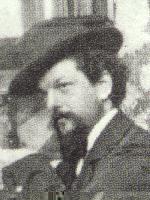Claude Debussy (1862-1918)
 (born
St. Germain-en-Laye, 22 August 1862; died Paris, 25 March 1918).
(born
St. Germain-en-Laye, 22 August 1862; died Paris, 25 March 1918).
He studied with Guiraud and others at the Paris Conservatoire (1872-84)
and as prizewinner went to Rome (1885-7), though more important Impressions
came from his visits to Bayreuth (1888, 1889) and from hearing Javanese
music in Paris (1889). Wagner's influence
is evident in the cantata "La damoiselle élue" (1888) and the "Cinq
poèmes de Baudelaire" (1889) but other songs of the period, notably
the settings of Verlaine ("Ariettes oubliées", "Trois mélodies",
"Fêtes galantes", set 1) are in a more capricious style, as are parts
of the still somewhat
Franckian "G Minor String
Quartet" (1893); in that work he used not only the Phrygian
mode but also less standard modes, notably the whole-tone
mode, to create the floating harmony
he discovered through the work of contemporary writers: Mallarmé
in the orchestral "Prélude à 'L'après-midi d'un faune'"
(1894) and Maeterlinck in the opera "Pelléas et Mélisande",
dating in large part from 1893-5 but not completed until 1902. These works
also brought forward a fluidity of rhythm and color
quite new to Western music.
"Pelléas," with its rule of understatement and deceptively simple
declamation, also brought an entirely new tone to
opera
- but an unrepeatable one. Debussy worked on other opera projects and left
substantial sketches for two pieces after tales by Poe ("Le diable dans
le beffroi" and "La chûte de la maison Usher"), but nothing was completed.
Instead the main works were orchestral pieces, piano sets and songs.
The orchestral works include the three "Nocturnes"
(1899), characteristic studies of veiled harmony
and texture ('Nuages'), exuberant cross-cutting ('Fêtes')
and seductive whole-tone drift ('Sirènes').
"La mer" (1905) essays a more symphonic form, with a finale that works
themes from the first movement, though the centerpiece ('Jeux de vagues')
proceeds much less directly and with more variety of color. The three "Images"
(1912) are more loosely linked, and the biggest, 'Ibéria', is itself
a triptych, a medley of Spanish allusions. Finally the ballet "Jeux" (1913)
contains some of Debussy's strangest harmony and texture in a form that
moves freely over its own field of motivic connection. Other late stage
works, including the ballets Khamma (1912) and La boîte
à joujoux (1913) and the mystery play Le martyre de St. "Sébastien"
(1911), were not completely orchestrated by Debussy, though "St. Sébastien"
is remarkable in sustaining an antique modal atmosphere that otherwise
was touched only in relatively short piano pieces (e.g.'La cathédrale
engloutie').

The important piano music begins with works which, Verlaine fashion,
look back at rococo decorousness with a modern cynicism and puzzlement
("Suite bergamasque," 1890; "Pour le piano," 1901). But then, as in the
orchestral pieces, Debussy began to associate his music with visual impressions
of the East, Spain, landscapes etc., in a sequence of sets of short pieces.
His last volume of "Etudes" (1915)
interprets similar varieties of style and texture purely as pianistic exercises
and includes pieces that develop irregular form to an extreme as well as
others influenced by the young Stravinsky
(a presence too in the suite "En blanc et noir" for two pianos, 1915).
The rarefaction of these works is a feature of the last set of songs, the
"Trois poèmes de Mallarmé" (1913), and of the "Sonata for
flute, viola and harp" (1915), though the sonata
and its companions also recapture the inquisitive Verlainian classicism.
The planned set of six sonatas was cut short by the composer's death from
rectal cancer.
(see Claude Debussy's Musical
Style article)
(hear Arabesque No. 1)

 (born
St. Germain-en-Laye, 22 August 1862; died Paris, 25 March 1918).
(born
St. Germain-en-Laye, 22 August 1862; died Paris, 25 March 1918).